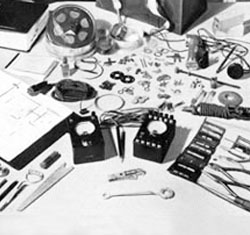
Contrast this with the active output stage of Figure 1. Here, grounding one side reduces the output from 2 volts to 1 volt. Though this is a one time gain reduction (correctable by increasing the level 6 dB), it bothers some. Mark off points.
Of more concern is the 6 dB lost of headroom. A desirable aspect of differentially driving interconnecting lines is the ability to get 6 dB more output level from the same power supply rails.
Most audio products use op-amps running from ±15 volt rails. A single op-amp drives an unbalanced line to around ±11 volts peak (+20 dBu). Using two op-amps to drive the line differentially doubles this to ±22 volts peak (one goes positive, while the other goes negative), a value equal to +26 dBu. Mark off more points for loss of headroom.
Mark off even more points for potential distortion (depends on op-amps, and exact configuration), oscillation, and failure, resulting from asking one side to drive a short (the result of grounding one side for unbalanced operation).
These three things: 6 dB loss of gain, 6 dB loss of headroom, and the questionable practice of allowing an op-amp to drive a short, sparked creation of the cross-coupled output stage. It solves two out of three.
Cross-coupled output stages do two things active differential output stages do not. They maintain the same gain either balanced or unbalanced. And they protect themselves from having to drive a short. But they still have 6 dB loss of headroom .
A point not understood by many users. They believe that cross-coupled output stages behave exactly like transformers. Not true. They have the same headroom limitation as all op-amp designs operating from ±15 volt power supplies. (Some equipment uses ±18 volts, but this only results in a 2 dB difference for unbalanced.)
MCI’s original design [ 1] appears in Figure 5. MCI used two op-amps, wired such that the opposite output subtracted from twice the input signal (not particularly obvious, but true). That way, each side’s gain looks like a gain of one for balanced operation, i.e., 1 volt in, gives ±1 volt out. Yet shorting one side (running unbalanced) gives a gain of two (nothing to subtract).
Since cross-coupled and normal differential output stages use essentially the same parts (and therefore cost the same), a fair question is why don’t you see more of the former? The answer lies in the perils of positive feedback.
Inherent to the operation of cross-coupled output stages is positive feedback. The subtraction process created by cross-coupling opposite outputs, has an undesirable side effect of being positive feedback.
Because of this, op-amp matching, resistor ratio matching and temperature compensation becomes critical. If not done properly, cross-coupled stages drift and eventually latch-up to the supply rails. (This is why you see so many variations of Figure 5, with all sorts of excess baggage glued on.
Things like capacitive-coupled AC feedback, fixed loading resistors, high-frequency gain roll off capacitors, offset trims, etc.) The difficulty in controlling these parameters in high volume production, leads most manufacturers to abandon its use.
Analog Devices helped solve these problems by putting all the elements into one integrated circuit [ 2]. Their monolithic IC version (which Rane uses in select products) operates on the same principles as MCI’s, although Analog Devices uses three op-amps to drive the input differentially. Here precise control and laser trimming guarantees stable performance, and opens up a new chapter in cross-coupled output stage use.
References
[1] T. Hay, “Differential Technology in Recording Consoles and the Impact of Transformerless Circuitry on Grounding Technique,” presented at the 67th Convention of the Audio Engineering Society, J. Audio Eng. Soc. (Abstracts) , vol. 28, p. 924 (Dec. 1980).
[2] “SSM-2142 Balanced Line Driver,” Audio/Video Reference Manual , pp. 7-139 (Analog Devices, Norwood, MA, 1992). Reproduced with permission from S&VC , vol. 8, no. 9, Sept. 20, 1990, pp. 10-20.
Dennis Bohn is a principal partner and vice president of research & development at Rane Corporation. He holds BSEE and MSEE degrees from the University of California at Berkeley. Prior to Rane, he worked as engineering manager for Phase Linear Corporation and as audio application engineer at National Semiconductor Corporation. Bohn is a Fellow of the AES, holds two U.S. patents, is listed in Who’s Who In America and authored the entry on “Equalizers” for the McGraw-Hill Encyclopedia of Science & Technology, 7th edition.
